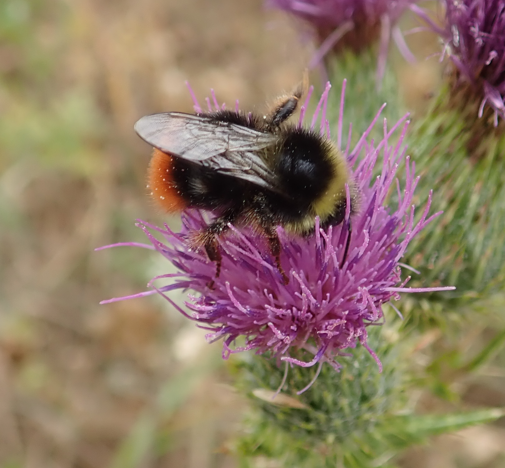Hitchin Cemetery July 2022
Hitchin Cemetery July 2022
At the start of July the cemetery was still looking fairly green, with some lovely flowers benefitting from the longer grassy conservation areas with Wild Carrot, Knapweed, Lady's Bedstraw, Ragwort and many others.
The third cemetery guided tour took place on 17th July with the highest attendance so far. Twenty six people enjoyed the tour (although I had Covid & had to leave the tour in the capable hands of the leader of the Cemetery Friends group, Veronica). During July we also were visited by a representative from the Council for the Protection for Rural England because we have been nominated for a community award and we will find out later in the year if we are successful.
One of the improvements in recent years has been the introduction of borders, planted by the Cemetery Friends group, and the taller plants were attracting the eye...
Blue Globe Thistles, which in particular have withstood the recent drought and been loved by honey bees.
The extreme heat has suited the grasshoppers & I managed to spot a Common Field Grasshopper basking on a gravestone and a Roesel's Bush-cricket nicely camouflaged on Yellow Rattle seed-heads. Roesel's Bush-crickets used to be confined, in England, to the south coast but have now spread over much of the country. They come in two different forms, mostly without wings but usually about 1% are winged, but in a hot year this percentage increases which means the species spreads more when conditions are favourable, so there should be plenty with wings this year!
July is a peak time for butterflies and moths and there has been a selection to see...Common Blue and Meadow Brown butterflies on Knapweed
Gatekeeper butterfly on Wild Marjoram
Five Spot Burnet moth on Ragwort and Brassy Longhorn moth, with its immensely long antennae, on Scabious
There was a new Bee Hotel installed over winter and it is proving very popular. It has holes of various sizes, which attract different species, and a tiny black wasp was using a 2mm diameter hole. I have had this identified as a Little Mason Wasp and it appears to be the first ever Hertfordshire record of this species! A bee or wasp will lay her eggs in a hole, depending on the species anytime from spring to high summer, in a line from the back towards the front, and provision it with pollen, then seal the entrance. Here you can see many of the holes have been sealed. The eggs became larvae, then pupae then emerge as adults and break out of the sealed hole. The bee or wasp nearest the front emerges first, then the next in line and so on.
A selection of other smart insects (and one arachnid) loved the flowers...
A Black and Yellow Longhorn Beetle and a Turnip Sawfly...
A Red Tailed Bumble Bee and a Harvestman. Harvestmen, or Harvesters, are arachnids similar to spiders but have only one body part, whereas spiders have two.
There have been families of birds breeding in the cemetery which benefit directly or indirectly from all the plant and insect life...
Just a reminder: there is one last opportunity this year to come on a guided cemetery tour: Friday 12th August at 10:30. Meet at the chapel and learn about the history & wildlife of the cemetery.






















Comments
Post a Comment